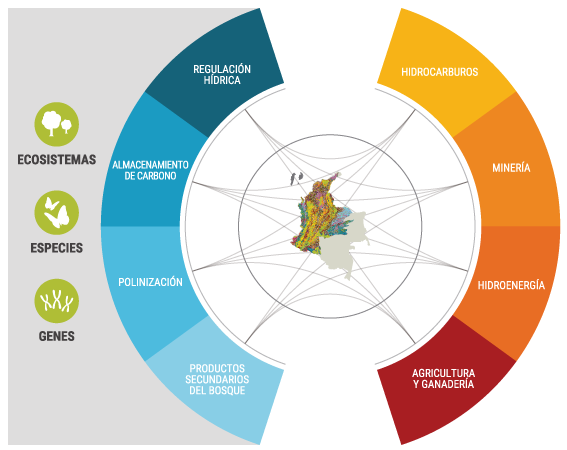Population increases, along with policies for an extractive economic development, reinforce the need of implementing effective strategies to ensure the protection, mitigation, and prevention of threats and using Colombian biological diversity in an adequate and sustainable fashion.
The integrated management of biodiversity and its ecosystem services requires the appeasement of conservation with development. This is specially necessary in a megadiverse, polyethnic, and multicultural country like Colombia that still has pending challenges in its development such as the great number of regions with unsatisfied basic necessities and high levels of illiteracy and infant mortality, among others.
The offer of natural resources contains two aspects: biodiversity (at the gene, species, or ecosystem level) and ecosystem services. This natural supply is vital for guaranteeing the well-being of human populations, settlement of communities, and production of industrial goods. However, certain sectors, in spite of receiving benefits from natural resources, have negative impacts on the natural environment that may increase or decrease in the future depending on what type of development model the country chooses to implement.
The National Policy for the Integrated Management of Biodiversity and its Ecosystem Services1 clearly shows that ecological interactions between different organization levels of biodiversity result in ecosystem services, and these, in turn, are the base for the relationship of humans with nature. Therefore all actions that seek to conserve biodiversity are strategies for ensuring the long-term provision of ecosystem services, on which the country's development depends.
The "Environmental Planning for the Conservation of Biodiversity in the Areas of Influence of Ecopetrol" project, which was developed with the Humboldt Institute between 2012 and 2015, aimed to create management tools that could harmonize the supply of natural resources with needs of conservation and use, in addition to the requirements of different economic sectors. This resulted in a series of strategies and guidelines designed under a model of ecological and economical sustainability to manage the territory's biodiversity2.
The identified strategies are classified as conservation (preservation areas 23%, ecological restoration 18%, sustainable use 14%) or territorial (supplementary areas that function as land banks 18%, productive areas 15%, complementary areas 12%) tools that are key in processes of connectivity and support of natural areas. The percentages resulted in a balanced proportion of strategies to be implemented, showing that the equilibrium between conservation and development is possible when the resources are adequately used and tools for the correct management of the territory are incorporated.







